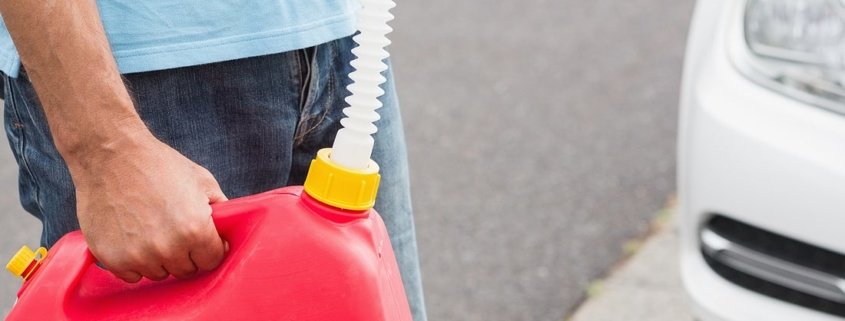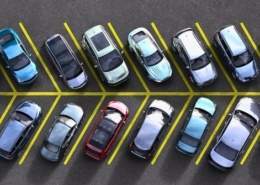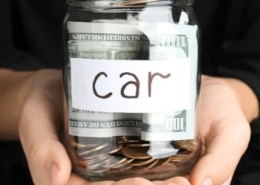Six Steps to Take Before Running Out of Gas
Almost a million people run out of gas every year. If you continue to push the needle past the empty line on your fuel gauge, it’s only a matter of time that you’ll end up on the side of the road also.
So what should you do if you’re about to run out of gas? The first thing to do is “not panic.” When your fuel light illuminates, you probably have 20 to 40 miles before your vehicle runs out of gas.
Although you have a few miles left to travel, you should take a few immediate steps before continuing to press forward. Especially if you’re in the middle of nowhere and have no idea how far it is to the nearest gas station.
Table of Contents
- Prepare in advance
- Six steps to take before running out of gas
- How far can you go before the light comes on?
- What if you run out of gas?
- Who do you call if you run out of fuel?
- What happens to your car?
- What if you run out of gas while driving?
- Should you flag someone down?
- Don’t let your gas tank get low
Prepare in Advance
You first want to check your paperwork and see if your vehicle came with roadside assistance and, if so, what exactly is covered and not covered. If you have coverage, store the information in your glove box or your phone. If you need to use the service, use it. It can save you a lot of frustration and aggravation if you run out of gas.
The best way to avoid this situation is not to let your vehicle get low on fuel. Make it a habit to fill up your vehicle whenever it reaches the halfway mark on the fuel gauge.
Always keep your tires properly inflated, don’t accelerate too quickly from a stop, and remember that a vehicle loaded with passengers and cargo will not get the same fuel economy as one that isn’t. This information can be found in the owner’s manual when buying a new car.
To clear up any misconceptions, here are six things the automotive experts at the Universal Technical Institute (UTI) and the American Automobile Association (AAA) say you should do when your low fuel light comes on before running out of gas:
Six steps to take before running out of gas in your car
1) Figure out where you’re at – Safely pull over to the side of the road and use your vehicle’s navigation system or smartphone to locate the nearest gas station. Many map apps and other apps help find gas stations and other essential business establishments. The American Automobile Association (AAA) has a great app available.
2) Turn off the air conditioner – You should turn off the A/C as soon as possible. It relieves the engine of additional load, which saves fuel. When the A/C system is running, it puts an extra burden on the alternator, which uses more energy to power the engine.
3) Roll up all of your windows – I know we just told you to turn off your air conditioner. You close all your windows to reduce wind resistance and drag. If you’re going to complain it’s too hot with the windows up and A/C turned off, how hot and tired will you be when pushing your car to the nearest gas station?
Keep your windows rolled up to reduce wind resistance. We know, but yes, you have to turn off the A/C and keep the windows rolled up. It would help if you thought of that before your tank got low.
4) Slow down immediately if possible – Studies have shown that a vehicle’s optimal speed of 35 to 45 mph is the most fuel-efficient. You must abide by traffic laws if you’re on a highway or interstate. Remember the tortoise and the hare. Slow and steady will win the race. Don’t speed up to get to the gas station quicker. The faster you go, or quicker you accelerate burns more fuel at a quicker rate.
5) Turn off any accessories – This one coincides with number two above. The fuel savings may be small, but turning off your stereo and unplugging any electrical devices (charging phones, iPads, tablets) could make the difference of a couple of thousand feet to the nearest fuel pump.
6) Coast using the lay of the land – This does not mean shutting the engine completely off. If you find yourself going downhill, shift the car into neutral to give your engine a little break. Shifting your vehicle into neutral will still use your power steering, making it easier to maneuver and handle the car.
There is no standard in the industry mandating automakers to provide you with a certain amount of mileage before your car runs out of gas. The golden rule is that once your low-level fuel light illuminates, you have roughly 40 miles before you become stranded on the side of the road.
Suppose you’re the type of person who loves to live on the edge by seeing how far you can push your vehicle to empty. Try doing this to narrow down your estimate of how far you can drive after your low gas light comes on:
How to estimate how far you can go before your low fuel light comes on?
- Once your fuel light illuminates, immediately head to a gas station and fill your tank.
- Write down how many gallons of fuel your car took to fill up.
- Take the capacity of your car’s fuel tank and subtract the number of gallons it took. If you have a 14-gallon tank and your car took 11.5 gallons, your fuel light is illuminated with 2.5 gallons left.
- You can multiply that number by your vehicle’s average estimated fuel economy. The results will tell you how many miles you can drive when your low-fuel light comes on. Two and a half gallons times, let’s say 28 mpg equals 70 miles before your vehicle is out of gas.
The reason cars come equipped with a low-fuel light is to let you know you need to stop and add fuel to your tank. Many experts say, “once the gauge hits a quarter of a tank, way before the low-fuel light illuminates, you should resist the urge to keep driving and stop to fill up your tank.” This will keep sludge and other contaminants in the bottom of your tank from being sucked up into the engine’s fuel system and cause your vehicle’s fuel line to clog, causing costly mechanical repairs.
What if you do run out of gas?
If you did run out of gas on the highway or in a rural area, the best thing to do is pull over to the side of the road, figure out where you are, and phone for assistance. Several services, such as your auto insurance provider, AAA, family, and friends, or 9-1-1, can assist you in getting out of a bind.
Who do you call if you run out of gas?
When you run out of gas, an essential thing to remember is to keep a cool head and remember that there are a lot of people who can assist you get out of your jam:
- AAA – Call the American Automobile Association if you’re a current member. You may have a membership through a credit card, loan, etc., and not even realize it. If you’re not a member, try the options below.
- Car Insurance – If you do not have AAA, you should contact your vehicle insurance company. Most car insurance policies have a towing clause that covers one tow per year. If not, you might want to look into the cost of a tow truck and then determine whether or not to utilize it to go to a petrol station.
- Friends or family – While it is rare that you would run out of gas at a location where friends or family can rush to your aid, it is worth calling them to inform them of the situation if the previous two calls are unsuccessful. At the absolute least, they should be able to assist you by making a few calls of their own to help you out.
- 9-1-1 — Although running out of fuel may not appear to be an emergency, contacting 9-1-1 if all else fails is not a bad idea. If you are obstructing traffic in any way or believe that the placement of your car is endangering you or other vehicles, you will be prioritized.
What happens to your automobile when you run out of gas?
The “great news” about running out of gas is that your engine does not automatically shut down when the tank is empty. There will be many warning indicators that, when paired with the empty symbol on your fuel gauge, should provide ample warning that your gasoline supply has been exhausted and that it is time to pull over to the side of the road safely.
- Loss of Power – This will be one of the first symptoms of a low gas tank and is particularly evident while driving uphill. If you push the gas pedal and the car does not accelerate, it is most likely due to a lack of gasoline.
- Jerking – This will be felt like a surging feeling from behind the wheel, almost as if your automobile comes to a complete stop and thrusts ahead; gasoline supply inconsistencies cause this.
- Engine Sputtering – This sounds like the engine is hiccuping or burping and is caused by too much air entering the cylinder and insufficient fuel.
- Engine Backfire – While unusual in modern cars, a loud pop coming from the tailpipe, similar to a firework going off, may also indicate that you are out of gas.
What should you do if Your Car Runs Out of Gas While Driving?
- Pull safely off the right side of the roadway, put your car in park, and switch on your hazards.
- Determine the precise position of your car to assist possible rescuers.
- Call AAA, insurance, friends or family, and 9-1-1 if needed.
- If you cannot call for whatever reason, try flagging down a passing car for assistance. ( last resort )
- If everything else fails, go to the nearest gas station for assistance.
Flagging down someone when running out of gas
Calling for assistance should be the usual procedure when dealing with a car that has run out of gas on the highway or in a rural area.
However, there will be times when you will be trapped without cell phone service. If this is the case, you may need to consider hailing another car for assistance.
Always keep “safety first” in mind. When signaling for assistance, you must be in a conspicuous place that is highly visible and well out of the traffic path. Avoid standing on curves and corners, and wear bright clothing or other items that will attract the notice of pedestrians and vehicles passing by.
If you call for help or not, there will very certainly be a good Samaritan, or two, who see you are trapped and stop to offer assistance. While the majority of individuals have good intentions and will provide you with helpful service, there are a few things you should keep in mind to help protect yourself:
- Request that they make a phone call on your behalf. The next best option for seeking assistance from bystanders is to ask them to go to a cell coverage area and make a call for you. Once they’ve done that, ask them if they can return and give you an update on when you may expect aid to arrive.
- Respectfully request that they bring you some fuel. If another car comes to your aid, the most significant thing they can do is provide you with some gas while you wait with your vehicle.
- Request a ride from them. The final resort should be to request a ride to and from the petrol station. Be extra wary if a stranger stops and asks to give you a ride uninvitedly or if one of the above alternatives is refused and the stranger persists in giving you a ride.
Don’t let your gas tank get to low
It’s not a terrible idea to keep your fuel tank from dropping under a quarter tank. In fact, keeping your gas tank above half or “topped-off” is a smart idea.
A full tank not only protects you from running out of gas, but a low gas tank full of air can cause oxidation and gunky buildup in your tank. This may have a detrimental influence on your vehicle’s fuel economy and engine efficiency in the long run.
Shopping for a new car?
Before visiting a dealership to buy a new car, it’s essential to know the dealer invoice price and what other people are paying for the vehicle in your local area. Otherwise, you won’t know a reasonable price to pay for any car you’re looking to buy.
Learn how to have dealers compete with each other online before ever stepping foot inside a dealership to guarantee you pay the best new car price and avoid any modern-day car dealer scams.
I highly recommend using an online referral service such as Ryde Shopper or Motor Trend. Their quotes will automatically include any discounts or cash-back incentives currently available in the marketplace.














